Opinion & Analysis
The blind spot of PGA Tour players: Long-iron play

With the PGA Tour’s season winding down to the final tournament of the year, there will be a faction of golfers fighting to make the top 125 on the Money List in order to keep their Tour Card for 2013. I have personally worked with a few PGA Tour players, their caddies and instructors on understanding the game from a statistical standpoint.
When I started the 2012 season working with these clients there were a couple of parts of our initial interaction that surprised me:
1) Each player had made it their goal to be ‘one of the best wedge players on Tour.’
2) Each client initially did not buy into me telling them that in the grand scheme of things, full shot wedge play is not overly important. Particularly on the PGA Tour.
With the PGA Tour’s ShotLink data, the numbers are on display for statisticians like me to decipher the level of importance of each part of the game of golf. It’s very similar to the movie Moneyball and the approach Oakland A’s General Manager, Billy Beane, utilized to build his team based on the cold, hard numbers instead of traditional baseball axioms. But even better, there are far less “moving parts” in the game of golf, making the numbers more distinct and easier to see the correlation to success on Tour.
Despite that, there is still plenty of resistance to approaching the game of golf from a metrics standpoint and every year there are about 75 full time PGA Tour golfers wondering where their entire season went wrong.
***
My development into metrics and the game of golf actually started back when I was only five years old. I immediately took to the game of baseball and each week my dad would go to the local store and grab a few packs of baseball cards and give them to me where I would collect them. Eventually I would spend my entire time reading and studying each card. One of the fascinating parts of baseball is the amount of record keeping of statistics the sport has, dating back to the 19th century.
One of my favorite all-time baseball managers was Billy Martin as he would keep some data on how well certain batters performed against certain pitchers. In fact, in the 1977 American League Championship Series, Martin benched superstar Reggie Jackson because Kansas City’s starting pitcher was Paul Splittorff, who had owned Jackson each time they faced each other. Almost every baseball expert thought Martin was insane, but in the end the Yankees won the game 5-3 and went on to beat the Dodgers to win the World Series.
For better or for worse, statistics lends way to contrarian type of thinking. But if analyzed diligently and with an open mind, it can uncover truths that have eluded even the greatest experts for centuries.
In my own personal journey of golf, I had never understood what the golf term “scoring” exactly meant. Often times, hearing the words “I scored well’ left me with more questions than answers. Generally I would hear it referred to putting and chipping well, but I had plenty of rounds where I shot a low score and did not putt or chip all that well. In fact, one of my lowest rounds ever (64) came with a 4-putt.
With that, I decided to look into the ShotLink data and use my background in statistics to see if I could figure out the level of importance that certain parts of the game have on the success of PGA Tour golfers. In the process, I wound up uncovering a truth that has been long ignored by countless Tour players.
***
Before I go on, the wedge game does matter in the game of golf. In fact, every part of the game matters in the game of golf. If a golfer improves his fairway bunker play, that will lower their scores over a period of time. However, if a golfer improves their putting, that will have a bigger impact on lowering their scores than if they were to just improve their fairway bunker player. Thus, a metrics based approach to golf is about determining the level of importance that certain parts of the game have and then focusing on improving the parts of the game that have the highest level of importance in order to improve a golfer’s scores.
One of my first observations was that Tour players typically do not hit the ball well from every location with every type of club in the bag. The golfers considered to be top tier ballstrikers are usually good off the tee and then excel with certain irons like the mid-irons or the long irons or with their wedges. But to find a golfer who can hit it well off the tee and hit it well with each iron is quite rare.
I ended up splitting the game in different categories like Driving Effectiveness, Putts Gained and Short Game Play. But for the approach shots, I split them into the following categories:
- Birdie Zone Play (shots from 75-125 yards)
- Safe Zone Play (shots from 125-175 yards)
- Danger Zone Play (shots from 175-225 yards)
What I uncovered was that Danger Zone Play has the strongest correlation to success on Tour than ANY other part of the game, including putting and driving effectiveness. And it has a far stronger correlation to success on Tour than Safe Zone Play and Birdie Zone Play. Despite that, these clients of mine on the PGA Tour would tell me how important it was for them to be one of the best wedge players on Tour.
While I was a little frustrated with their desires to be the best at a part of the game that was relatively unimportant to their success, I did understand where they were coming from. I had to remember that before I did this statistical research, I had the same ideas of good Tour players would almost always get up-and-in on any shot from inside 100 yards. And if a Tour player was unable to execute from that distance, they would not find themselves on Tour for very long. This led me to wondering where this faulty thinking came from.
***
Currently, the leader in Birdie Zone play is Steve Stricker, who has hit his Birdie Zone shots an average of 15.74 feet to the cup. The average Tour player from the Birdie Zone has hit his shots 20.35 feet to the cup.
The general misconception for golfers, including actual PGA Tour golfers, is that once a good Tour player gets a wedge in their hands they will hit it close and have a tap in putt. But as the data shows, that is far from the reality. The best player from 75-125 yards is averaging almost 16 feet left to the cup on shots from this range. The average Tour player is leaving it over 20 feet to the cup.
Furthermore, the Tour average putts made percentage from 15-20 feet is only 18.3 percent. From 20-25 feet the average make percentage on Tour is 11.7 percent. Therefore, Tour players are not having a lot of tap-ins when they get a full swing wedge in their hand, but also their odds of getting up-and-in with a full swing wedge in their hands are slim at best.
Still, we need to see what the correlation between Birdie Zone Play and success on Tour actually. To give a better idea, take a look at the top-10 Birdie Zone players in 2012 and their ranking on the Money List:
Here’s a list of the players in the bottom-10 of Birdie Zone Play and their Money Ranking:
Out of the players in both lists, the bottom-10 in the Birdie Zone actually have 6 players in the top-100 on the Money List versus the top-10 Birdie Zone players which only has 5 players in the top-100 on the Money List.
Let’s compare that to the best and the worst of the Danger Zone golfers. Here is the top-10 Danger Zone golfers and their rankings on the Money List:
Here’s the bottom-10 in Danger Zone play:
Every single player in the top-10 in the Danger Zone will be in the top-125 on the Money List in 2012, regardless of what happens at Disney. But even better, those who have finished in the top-10 in the Danger Zone have had resounding success on Tour this year. Whereas four of the top-10 Birdie Zone golfers (Mulroy, Taylor, Thatcher and O’Hern) will likely have to win at Disney in order to finish in the top-125 on the Money List.
This is the blind spot for many PGA Tour players. They keep working doggedly on their wedge game whereas if they used their efforts towards the longer irons and hybrids, they would almost assuredly keep their card and get closer to nirvana, winning a PGA Tour event.
I think the cause of the ‘blind spot’ is television. Television producers are far more interested in shots that wind up close to the pin than the shots that actually have a greater impact of a golfer separating themselves from the rest of the field. That is why we see so much putting on televised rounds, those are the shots that golfers are most likely to make. When it comes to full swing shots, golfers are more likely to hit a wedge shot closer to the pin. And to make it even more visually appealing, wedge shots are more likely to get backspin as well.
Thus, the perception is that Tour players stick every wedge shot and get up-and-in with ease. That is what we usually see every week on TV. The reality is far different and that the more spectacular shot happens when a golfer hits a 190 yard shot to 15-feet with no back spin. But television ratings always take precedent over mundane facts.
Click here for more discussion in the “Tour Talk” forum.
- LIKE10
- LEGIT1
- WOW3
- LOL0
- IDHT0
- FLOP0
- OB0
- SHANK0
19th Hole
Vincenzi’s LIV Golf Singapore betting preview: Course specialist ready to thrive once again

After another strong showing in Australia, LIV Golf will head to Sentosa Golf Club in Singapore looking to build off of what was undoubtedly their best event to date.
Sentosa Golf Club sits on the southern tip of Singapore and is one of the most beautiful courses in the world. The course is more than just incredible scenically; it was also rated 55th in Golf Digest’s top-100 courses in 2022-2023 and has been consistently regarded as one of the best courses in Asia. Prior to being part of the LIV rotation, the course hosted the Singapore Open every year since 2005.
Sentosa Golf Club is a par 71 measuring 7,406 yards. The course will require precise ball striking and some length off the tee. It’s possible to go low due to the pristine conditions, but there are also plenty of hazards and difficult spots on the course that can bring double bogey into play in a hurry. The Bermudagrass greens are perfectly manicured, and the course has spent millions on the sub-air system to keep the greens rolling fast. I spoke to Asian Tour player, Travis Smyth, who described the greens as “the best [he’s] ever played.”
Davis Love III, who competed in a Singapore Open in 2019, also gushed over the condition of the golf course.
“I love the greens. They are fabulous,” the 21-time PGA Tour winner said.
Love III also spoke about other aspects of the golf course.
“The greens are great; the fairways are perfect. It is a wonderful course, and it’s tricky off the tee.”
“It’s a long golf course, and you get some long iron shots. It takes somebody hitting it great to hit every green even though they are big.”
As Love III said, the course can be difficult off the tee due to the length of the course and the trouble looming around every corner. It will take a terrific ball striking week to win at Sentosa Golf Club.
In his pre-tournament press conference last season, Phil Mickelson echoed many of the same sentiments.
“To play Sentosa effectively, you’re going to have a lot of shots from 160 to 210, a lot of full 6-, 7-, 8-iron shots, and you need to hit those really well and you need to drive the ball well.”
Golfers who excel from tee to green and can dial in their longer irons will have a massive advantage this week.
Stat Leaders at LIV Golf Adelaide:
Fairways Hit
1.) Louis Oosthuizen
2.) Anirban Lahiri
3.) Jon Rahm
4.) Brendan Steele
5.) Cameron Tringale
Greens in Regulation
1.) Brooks Koepka
2.) Brendan Steele
3.) Dean Burmester
4.) Cameron Tringale
5.) Anirban Lahiri
Birdies Made
1.) Brendan Steele
2.) Dean Burmester
3.) Thomas Pieters
4.) Patrick Reed
5.) Carlos Ortiz
LIV Golf Individual Standings:
1.) Joaquin Niemann
2.) Jon Rahm
3.) Dean Burmester
4.) Louis Oosthuizen
5.) Abraham Ancer
LIV Golf Team Standings:
1.) Crushers
2.) Legion XIII
3.) Torque
4.) Stinger GC
5.) Ripper GC
LIV Golf Singapore Picks
Sergio Garcia +3000 (DraftKings)
Sergio Garcia is no stranger to Sentosa Golf Club. The Spaniard won the Singapore Open in 2018 by five strokes and lost in a playoff at LIV Singapore last year to scorching hot Talor Gooch. Looking at the course setup, it’s no surprise that a player like Sergio has played incredible golf here. He’s long off the tee and is one of the better long iron players in the world when he’s in form. Garcia is also statistically a much better putter on Bermudagrass than he is on other putting surfaces. He’s putt extremely well on Sentosa’s incredibly pure green complexes.
This season, Garcia has two runner-up finishes, both of them being playoff losses. Both El Camaleon and Doral are courses he’s had success at in his career. The Spaniard is a player who plays well at his tracks, and Sentosa is one of them. I believe Sergio will get himself in the mix this week. Hopefully the third time is a charm in Singapore.
Paul Casey +3300 (FanDuel)
Paul Casey is in the midst of one of his best seasons in the five years or so. The results recently have been up and down, but he’s shown that when he’s on a golf course that suits his game, he’s amongst the contenders.
This season, Casey has finishes of T5 (LIV Las Vegas), T2 (LIV Hong Kong), and a 6th at the Singapore Classic on the DP World Tour. At his best, the Englishman is one of the best long iron players in the world, which makes him a strong fit for Sentosa. Despite being in poor form last season, he was able to fire a Sunday 63, which shows he can low here at the course.
It’s been three years since Casey has won a tournament (Omega Dubai Desert Classic in 2021), but he’s been one of the top players on LIV this season and I think he can get it done at some point this season.
Mito Pereira +5000 (Bet365)
Since Mito Pereira’s unfortunate demise at the 2022 PGA Championship, he’s been extremely inconsistent. However, over the past few months, the Chilean has played well on the International Series as well as his most recent LIV start. Mito finished 8th at LIV Adelaide, which was his best LIV finish this season.
Last year, Pereira finished 5th at LIV Singapore, shooting fantastic rounds of 67-66-66. It makes sense why Mito would like Sentosa, as preeminent ball strikers tend to rise to the challenge of the golf course. He’s a great long iron player who is long and straight off the tee.
Mito has some experience playing in Asia and is one of the most talented players on LIV who’s yet to get in the winner’s circle. I have questions about whether or not he can come through once in contention, but if he gets there, I’m happy to roll the dice.
Andy Ogletree +15000 (DraftKings)
Andy Ogletree is a player I expected to have a strong 2024 but struggled early in his first full season on LIV. After failing to crack the top-25 in any LIV event this year, the former U.S. Amateur champion finally figured things out, finished in a tie for 3rd at LIV Adelaide.
Ogletree should be incredible comfortable playing in Singapore. He won the International Series Qatar last year and finished T3 at the International Series Singapore. The 26-year-old was arguably the best player on the Asian Tour in 2023 and has been fantastic in the continent over the past 18 months.
If Ogletree has indeed found form, he looks to be an amazing value at triple-digit odds.
- LIKE3
- LEGIT3
- WOW1
- LOL2
- IDHT0
- FLOP2
- OB0
- SHANK0
Opinion & Analysis
Ryan: Lessons from the worst golf instructor in America

In Tampa, there is a golf course that boasts carts that do not work, a water range, and a group of players none of which have any chance to break 80. The course is overseen by a staff of crusty men who have succeeded at nothing in life but ending up at the worst-run course in America. However, this place is no failure. With several other local courses going out of business — and boasting outstanding greens — the place is booked full.
While I came for the great greens, I stayed to watch our resident instructor; a poor-tempered, method teacher who caters to the hopeless. At first, it was simply hilarious. However, after months of listening and watching, something clicked. I realized I had a front-row seat to the worst golf instructor in America.
Here are some of my key takeaways.
Method Teacher
It is widely accepted that there are three types of golf instructors: system teachers, non-system teachers, and method teachers. Method teachers prescribe the same antidote for each student based on a preamble which teachers can learn in a couple day certification.
Method teaching allows anyone to be certified. This process caters to the lowest caliber instructor, creating the illusion of competency. This empowers these underqualified instructors with the moniker of “certified” to prey on the innocent and uninformed.
The Cult of Stack and Jilt
The Stack and Tilt website proudly boasts, “A golfer swings his hands inward in the backswing as opposed to straight back to 1) create power, similar to a field goal kicker moving his leg in an arc and 2) to promote a swing that is in-to-out, which produces a draw (and eliminates a slice).”
Now, let me tell you something, there is this law of the universe which says “energy can either be created or destroyed,” so either these guys are defying physics or they have no idea what they are taking about. Further, the idea that the first move of the backswing determines impact is conjecture with a splash of utter fantasy.
These are the pontifications of a method — a set of prescriptions applied to everyone with the hope of some success through the placebo effect. It is one thing for a naive student to believe, for a golf instructor to drink and then dispel this Kool-Aid is malpractice.
Fooled by Randomness
In flipping a coin, or even a March Madness bet, there is a 50-50 chance of success. In golf, especially for new players, results are asymmetric. Simply put: Anything can happen. The problem is that when bad instructors work with high handicappers, each and every shot gets its own diagnosis and prescription. Soon the student is overwhelmed.
Now here’s the sinister thing: The overwhelming information is by design. In this case, the coach is not trying to make you better, they are trying to make you reliant on them for information. A quasi Stockholm syndrome of codependency.
Practice
One of the most important scientists of the 20th century was Ivan Pavlov. As you might recall, he found that animals, including humans, could be conditioned into biological responses. In golf, the idea of practice has made millions of hackers salivate that they are one lesson or practice session from “the secret.”
Sunk Cost
The idea for the worst golf instructor is to create control and dependency so that clients ignore the sunk cost of not getting better. Instead, they are held hostage by the idea that they are one lesson or tip away from unlocking their potential.
Cliches
Cliches have the effect of terminating thoughts. However, they are the weapon of choice for this instructor. Add some hyperbole and students actually get no information. As a result, these players couldn’t play golf. When they did, they had no real scheme. With no idea what they are doing, they would descend into a spiral of no idea what to do, bad results, lower confidence, and running back to the lesson tee from more cliches.
The fact is that poor instruction is about conditioning players to become reliant members of your cult. To take away autonomy. To use practice as a form of control. To sell more golf lessons not by making people better but through the guise that without the teacher, the student can never reach their full potential. All under the umbrella of being “certified” (in a 2-day course!) and a melee of cliches.
This of course is not just happening at my muni but is a systemic problem around the country and around the world, the consequences of which are giving people a great reason to stop playing golf. But hey, at least it’s selling a lot of golf balls…
- LIKE17
- LEGIT2
- WOW0
- LOL4
- IDHT1
- FLOP0
- OB0
- SHANK19
19th Hole
Vincenzi’s 2024 Zurich Classic of New Orleans betting preview

The PGA TOUR heads to New Orleans to play the 2023 Zurich Classic of New Orleans. In a welcome change from the usual stroke play, the Zurich Classic is a team event. On Thursday and Saturday, the teams play best ball, and on Friday and Sunday the teams play alternate shot.
TPC Louisiana is a par 72 that measures 7,425 yards. The course features some short par 4s and plenty of water and bunkers, which makes for a lot of exciting risk/reward scenarios for competitors. Pete Dye designed the course in 2004 specifically for the Zurich Classic, although the event didn’t make its debut until 2007 because of Hurricane Katrina.
Coming off of the Masters and a signature event in consecutive weeks, the field this week is a step down, and understandably so. Many of the world’s top players will be using this time to rest after a busy stretch.
However, there are some interesting teams this season with some stars making surprise appearances in the team event. Some notable teams include Patrick Cantlay and Xander Schauffele, Rory McIlroy and Shane Lowry, Collin Morikawa and Kurt Kitayama, Will Zalatoris and Sahith Theegala as well as a few Canadian teams, Nick Taylor and Adam Hadwin and Taylor Pendrith and Corey Conners.
Past Winners at TPC Louisiana
- 2023: Riley/Hardy (-30)
- 2022: Cantlay/Schauffele (-29)
- 2021: Leishman/Smith (-20)
- 2019: Palmer/Rahm (-26)
- 2018: Horschel/Piercy (-22)
- 2017: Blixt/Smith (-27)
2024 Zurich Classic of New Orleans Picks
Tom Hoge/Maverick McNealy +2500 (DraftKings)
Tom Hoge is coming off of a solid T18 finish at the RBC Heritage and finished T13 at last year’s Zurich Classic alongside Harris English.
This season, Hoge is having one of his best years on Tour in terms of Strokes Gained: Approach. In his last 24 rounds, the only player to top him on the category is Scottie Scheffler. Hoge has been solid on Pete Dye designs, ranking 28th in the field over his past 36 rounds.
McNealy is also having a solid season. He’s finished T6 at the Waste Management Phoenix Open and T9 at the PLAYERS Championship. He recently started working with world renowned swing coach, Butch Harmon, and its seemingly paid dividends in 2024.
Keith Mitchell/Joel Dahmen +4000 (DraftKings)
Keith Mitchell is having a fantastic season, finishing in the top-20 of five of his past seven starts on Tour. Most recently, Mitchell finished T14 at the Valero Texas Open and gained a whopping 6.0 strokes off the tee. He finished 6th at last year’s Zurich Classic.
Joel Dahmen is having a resurgent year and has been dialed in with his irons. He also has a T11 finish at the PLAYERS Championship at TPC Sawgrass which is another Pete Dye track. With Mitchell’s length and Dahmen’s ability to put it close with his short irons, the Mitchell/Dahmen combination will be dangerous this week.
Taylor Moore/Matt NeSmith +6500 (DraftKings)
Taylor Moore has quickly developed into one of the more consistent players on Tour. He’s finished in the top-20 in three of his past four starts, including a very impressive showing at The Masters, finishing T20. He’s also finished T4 at this event in consecutive seasons alongside Matt NeSmith.
NeSmith isn’t having a great 2024, but has seemed to elevate his game in this format. He finished T26 at Pete Dye’s TPC Sawgrass, which gives the 30-year-old something to build off of. NeSmith is also a great putter on Bermudagrass, which could help elevate Moore’s ball striking prowess.
- LIKE8
- LEGIT3
- WOW1
- LOL1
- IDHT0
- FLOP3
- OB1
- SHANK2
-

 19th Hole2 weeks ago
19th Hole2 weeks agoJustin Thomas on the equipment choice of Scottie Scheffler that he thinks is ‘weird’
-

 19th Hole2 weeks ago
19th Hole2 weeks ago‘Absolutely crazy’ – Major champ lays into Patrick Cantlay over his decision on final hole of RBC Heritage
-

 19th Hole3 weeks ago
19th Hole3 weeks agoTwo star names reportedly blanked Jon Rahm all week at the Masters
-

 19th Hole3 weeks ago
19th Hole3 weeks agoReport: LIV Golf identifies latest star name they hope to sign to breakaway tour
-

 19th Hole3 weeks ago
19th Hole3 weeks agoNeal Shipley presser ends in awkward fashion after reporter claims Tiger handed him note on 8th fairway
-

 19th Hole2 weeks ago
19th Hole2 weeks agoBrandel Chamblee has ‘no doubt’ who started the McIlroy/LIV rumor and why
-

 19th Hole1 week ago
19th Hole1 week agoLET pro gives detailed financial breakdown of first week on tour…and the net result may shock you
-

 Equipment2 weeks ago
Equipment2 weeks agoJason Day on his recent switch into Srixon ZX5 and ZX7 Mk II irons

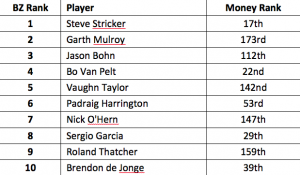
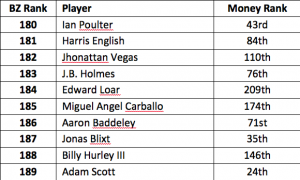
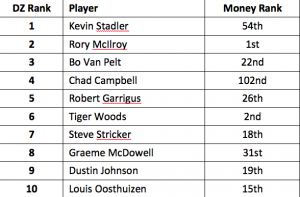
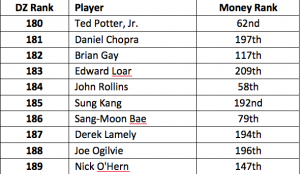












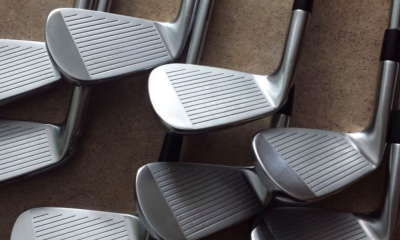
















Louis
Aug 10, 2014 at 5:25 am
You say a player who averages 15 feet from 100 yards has a slim chance of making birdie because tour pros only make 20% of their 15 footers. How about all the shots that land inside 15 feet though?
If you hit 30 shots and average 15 feet from 100 yards it means you will have 4 putts inside of 4 feet (let’s say you make 4), 6 from 5-10 (let’s say you make 3), 5 from 11-15 (let’s say you make 2), and 15 from 15-30 (let’s assume you make 2). That gives you a better than 33% chance of making birdie.
Winning tournaments comes from making birdies and not screwing up badly. Going from a 7% margin of error to 5% margin of error with long irons isn’t gonna make you score any better.
Not spraying your long irons will help immensely. Because that’s a really easy place to lose strokes.
Lesson: keep the ball in play (hit greens) with your long irons. That’s it. Don’t worry about being better than able to hit it within 50 feet of where you aim consistently (still hard to do). Going from 50 feet to 40 feet won’t help.
Eliminate inconsistencies that produce big misses.
Once you have that down, to score well, hitting the wedges closer is the easiest way.
Sam
Jun 18, 2013 at 5:33 am
Interesting stuff, here’s my 2cents worth…
PGA Tour players are just like other golfers, they follow trends. In the 90’s everyone on Tour jumped on the 52, 56, 60 bandwagon with Tom Kite, when he took distance control to a new level. Then along came Tiger with 48, 54, 58 and they all dumped a wedge. Lately, club lofts have changed the make up of sets, making 3 iron redundant in many cases (as shown above). The reason the DZ looks more important to scoring than the BZ is that relative to the other parts of their game the average PGA Tour Pro is poor in the BZ. The reason for this is simple: not enough tools to do the job. Modern PW clubs have become much stronger, instead of keeping the loft/distance gaps even, everyone followed Tiger and minimized the short end of their set. No doubt, more options and more full shot yardages will result in closer to the hole with wedges, it would be interesting to look at the correlation between number of scoring clubs and proximity to the hole, pretty sure you will find that guys with 3-4 wedges get it closer more often than the two club guys. Now that’s a blind spot!
JD
Nov 13, 2013 at 5:15 am
Interesting comment. But what I think you have failed to recognise is the fact PGA tour courses have become much longer and therefore require more clubs down the long end of the set make up. As a professional caddie and also a pro myself I have seen this first hand. There are also more courses with par 3 holes that are between 200-225 yards, couple that with longer par 4 holes that require longer, higher and softer shots players are forced into a hybrid as well as 3 irons. This is one reason I feel players are dumping the extra edge.
Mike
Feb 21, 2013 at 10:11 pm
The article is interesting but I am not sure that using Money List as a correlation to Birdie/Danger Zone is a statistically sound method. The Money List is a total of earnings but that is subject to a variable you have not accounted for which is the number of starts a player has on the Tour. Even an average PGA Tour player will have more money when they have more starts. A better comparison of earnings to player performance statistics would at least use “earnings per start” to eliminate the variable related to the number of starts.
Also, isn’t there some relationship between BZ, SZ and DZ that you have not accounted for? For example, Steve Stricker rates Top 10 in BZ and DZ efficiency and Adam Scott is 189th in BZ and obviously not Top 10 in DZ. One would think, based on the analysis, that Adam Scott would finish far below Steve Stricker yet the opposite is true. Scott (16 starts) actually finished with slightly higher earnings per start ($181,000) than did Stricker (19 starts and $180,000 per start).
Alex
Feb 14, 2013 at 2:40 pm
First of all great article…
Last year i actually kept record of 30 rounds and analyzed them through out. I took lowest 10 rounds and see what i did best during those rounds. This is what i found. 7 out of 10 rounds i hit 12 fairways each of those rounds, however also note i took more 3 woods and hybrids off the tee that left me a lot of 150-185 yard approaches. In those rounds i hit about 14 greens on avg. What this concluded for me is that i am a lot better hitting 7,6,5 and hybrids off the fairway than wedges from the rough. I am pretty decent putter and will not really 3 putt very often, however i will also not drain too many 20 footers for birdies. If Tour avg from the BZ is about 20 ft then i will be definitely over that, so as an amateur if i want to score better but more importantly consistently better i should be hitting 3/5 woods off the tees and hitting 7 irons into greens taking my 2 putts and going to the next hole. This is where this article is dead on, for me to get better either i need to drive better and be on the short grass with my driver leaving wedges in or improve my approaches from 150-185. Now what is easier to improve….
Jeff
Feb 14, 2013 at 12:00 pm
Great article, really can relate to this.
Dane
Feb 13, 2013 at 2:01 pm
Great article Mark. Being a golf professional this has put into writing what plenty of golf pros think. I will definitely look more into your work!
Philip
Feb 8, 2013 at 11:30 am
Wow! I think I need to become a statistician to analyze my golf game! Call me weird, but these are fun articles!
mark burk
Nov 5, 2012 at 9:28 am
All of the players you metion are good danger zone players are longer hitters and bad dangerzone players are short hitters. 175 to 225 for the good ones mention are mostly mid irons that can hold the firm pga tour greens, they also will be able to hit par 5’s in two more often which is where these guys make there birdies with shorter clubs and since most the par 3’s on tour are over 200 yards plays to the advantage of the longer hitters. So it would be better most of the world class player have good long game because of distance. If you want to talk about where weekend warrior can save shots it is with the shortgame. If a player can eliminate 3 putts and get up and down more often it will save them more strokes than being a good iron player from 175 to 225. Keeping the ball in play, eliminating 3 putts and decent short game will keep the score down for the average weekend golfer. Every time I go to range at my club the chipping and putting green are empty and the range is full. What will lower a score faster going from 38 putts a round to 30 or hitting good long iron or hybrid shots which will maybe be hit 4 times a round. This is for the weekend player
Richie Hunt
Nov 7, 2012 at 9:54 am
Mark,
I only showed the top-10 and bottom-10, but there is no substantative statistical correlation between distance off the tee or clubhead speed or a combination of the two and DZ play. And I have ran these numbers since 2003 for Distance and DZ play and thru 2007 for clubhead speed and DZ play.
There are plenty of examples of shorter hitting, low clubhead speed players that play great from the DZ each year. McDowell is ranked 8th in the DZ and not very long. Same with Stricker. Furyk is ranked 12th and routinely does great in the DZ. Same for other shorter hitters like David Toms (who was ranked #1 in 2011), Heath Slocum, and Zach Johnson.
Meanwhile there are longer hitters that struggle from the DZ. Like Chopra, Driscoll, Lamely, and Mark Anderson (currently ranked 174th) and Jhonattan Vegas (currently ranked 175th).
Distance helps…slightly. But it’s not enough help for Tour players to overcome a lack of skill in the Danger Zone.
Brett Adamkiewicz
Nov 1, 2012 at 11:03 am
What a well rounded article, and explained better than I have ever heard it. I have always taken a different thought process compared to the average joe. Not to exaggerate but we have all heard the phrase “drive for show and putt for dough” a million times. Fact of the matter is you will never win any “dough” if your superb putting skills are saving bogey and double bogeys all the time. On a side topic I am curious as too the percentage of penalty strokes taken in a round are due to tee shots and the “danger zone” shots. I know the phrase doesn’t exactly fit with the danger zone but it is all relative. 175 and out is what I call my scoring zone. I can have a bad putting and chipping day and still be sub 80. If I can’t get off the tee and can’t get around the green, the limit on my score…. I am taking a trip with 7 of my buddies to Kiawah Island this weekend and I am going to put this to the test! Most of them are all mid to low handicappers and can play well! I am going to have a little fun with this and track their scoring relative to your “Danger Zone” and off the tee. Thank you for this article and I hope more people will read this and pay attention.
Brett Adamkiewicz
Nov 1, 2012 at 11:05 am
The sky is the limit on my score. Left out that part.
Dan
Oct 31, 2012 at 8:12 pm
Fantastic article, very insightful. It will be great to stop focusing on the “Glamorous” parts of the game and focus more on the shots that lower my score.
DaleH
Oct 31, 2012 at 5:02 pm
Exactly.. most amatures do struggle with the short game but really struggle with longer irons like myself. I’m usually on hitting into greens with say an 8 iron or less, 7-4 not as good, the longer the iron the the less my chances. Time to practice more on the long irons. Thanks for the facts.
Pingback: GolfWRX.com – The blind spot of PGA Tour players: Long-iron play | Golf Products Reviews